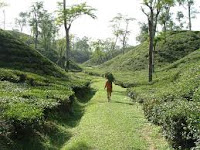Sylhet tea garden is natural beauty & assets of
Bangladesh:
In recent years, Bangladesh, particularly in the sub-Himalayan Panchagarh district, has seen a significant expansion of tea farming as an increasing amount of people became more interested in small-scale growing.
The tea industry in Bangladesh is an old yet underdeveloped industry. The first commercial tea garden was established in 1857 at Mulnichera in Sylhet, in the northeastern part of the country. By 1947, Bangladesh (then East Pakistan), owned 103 tea estates, covering 26,734 hectares of tea plantation with an annual production of 18.36 M.Kg and a yield of about 639 Kg. per hectare. In 1961, after a rapid increase of home consumption of tea, the government imposed a 3 percent mandatory extension of tea area per year. By 1970, the tea area was extended to 42,658 hectares and production was increased to 31.38 m.kg. However, the tea industry suffered significant damages during the liberation war in 1971, after poor management, insufficient inputs and inadequate maintenance led to lower yield and poor tea quality.
From 1980 to 1992, the Bangladeshi government, with the financial and technical help of British organizations, launched a massive development program to revitalize the tea industry. In 2006, Bangladesh produced 53 million kg. and exported 5 million kg, making it the tenth largest producer and fifteenth largest exporter of tea. Local tea companies, such as Kazi & Kazi, hope to increase exports and promote the country’s brand of tea.
The Bangladeshi tea industry has a huge potential for contributing to the economic development of the country and the improvement of overall socio-economic conditions of Bangladeshis, including small farmers and working women, in the tea growing districts.
The most recent figures show that over 7,000 skilled and unskilled workers, mostly women, have been working in 260 tea gardens, including 18 big estates, 13 medium-sized and 229 small-scale gardens, which are set up on about 2,200 acres of land in Tentulia and its surrounding areas. Small-scale tea growers usually sell their tea leaves to large tea processing factories such as Tentulia Tea Company Ltd. (TTCL) and Karotoa Tea Garden. These tea processing factories currently purchase their green tealeaves at Tk 11 (U.S. 16 cents) per kg.
Because of the increase of interest in tea farming and the significant potential of the tea industry, the Bangladeshi government and the Bangladesh Tea Board (BTB) have expressed interest in further developing the industry. Local tea growers, chamber leaders and officials have recommended to establish more tea processing industries, competitive markets for tea, and to resolve problems such as gas supply and the power crisis to help boost the tea sector.
Improvements in Bangladesh’s tea industry are hoped to increase wages and self-reliance of tea workers and small-scale farmers. Many of these workers and farmers hope that they can sell their green tea leaves at Tk 15 per kg. They also hope that their wages will increase from Tk 60 per day to Tk 100 per day.
Moreover, they hope that current labor regulations can be changed. Currently, there are no rules and regulations regarding the eight-hour working period, minimum wages, overtime payments, and the safety and security of workers. It is reported that the Bangladesh Small Tea Garden Owners’ Association is discussing labor regulations with authorities, who are trying to attract more domestic investors to boost the tea production sector.
It is obvious that it will take the combined work of the private and public sectors to improve the Bangladesh tea industry, which has a massive potential to help boost the overall economy of the country

































































No comments:
Post a Comment